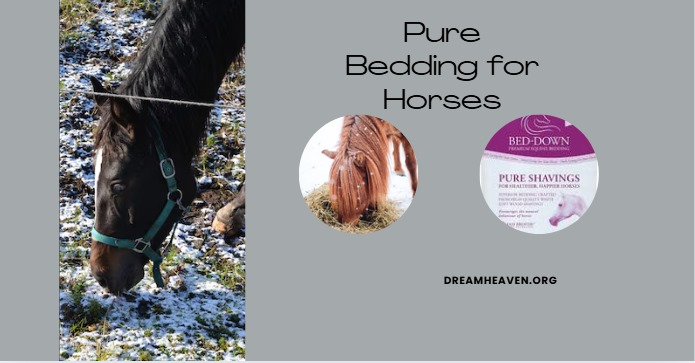Providing horses with clean, comfortable, and high-quality bedding is essential for their well-being and performance. Pure bedding for horses refers to bedding materials that are free from harmful chemicals, dust, and impurities, offering a healthier environment for your equine companions.
In this article, we’ll explore the different types of pure bedding, their benefits, and how to choose the best option for your horse’s specific needs.
Why Is Bedding Important for Horses?
Horse bedding serves multiple purposes, including:
Comfort: Provides a soft surface for horses to rest and lie down.
Absorption: Soaks up urine and moisture to keep the stable dry.
Insulation: Maintains warmth during cold weather.
Hygiene: Reduces ammonia buildup, minimizing respiratory risks.
Choosing pure bedding ensures your horse’s comfort while maintaining a clean and healthy stable environment.
Key Features of Pure Bedding for Horses
Low Dust Content
Dust-free bedding reduces respiratory issues in horses, particularly for those prone to allergies or asthma.
Natural and Non-Toxic
Pure bedding is free from harmful chemicals, dyes, and additives, ensuring safety for horses.
High Absorbency
Pure bedding materials absorb moisture effectively, keeping the stable dry and odor-free.
Biodegradability
Eco-friendly and compostable bedding options make waste management easier and more sustainable.
Types of Pure Bedding for Horses
Straw
Pros: Straw is a natural and cost-effective option commonly used in stables. It’s soft, warm, and easy to source.
Cons: Not as absorbent as other materials and requires frequent cleaning.
Shavings
Pros: Wood shavings are soft, absorbent, and widely available. They are easy to spread and provide good cushioning.
Cons: Ensure the shavings are free of harmful chemicals or treated wood.
Pellets
Pros: Made from compressed wood, bedding pellets are highly absorbent and expand when wet, making them efficient and economical.
Cons: Requires soaking before use to soften the texture.
Hemp
Pros: Hemp bedding is dust-free, biodegradable, and highly absorbent. It’s ideal for horses with respiratory issues.
Cons: Can be more expensive than other options.
Paper Bedding
Pros: Made from shredded paper, this bedding is dust-free, absorbent, and lightweight. It’s particularly suitable for horses with respiratory sensitivities.
Cons: Less insulating and may need frequent replacement.
Coconut Husk
Pros: A sustainable and eco-friendly option, coconut husk bedding is highly absorbent and controls odors effectively.
Cons: May not be as readily available as other types.
Rubber Mats (Supplementary)
Pros: Rubber mats can be used alongside pure bedding to provide cushioning and reduce the amount of bedding needed.
Cons: Initial setup cost can be high.
How to Choose the Right Pure Bedding
Consider Your Horse’s Needs
Horses with respiratory issues benefit from dust-free options like hemp or paper bedding.
Horses with sensitive skin require bedding free of chemicals or rough textures.
Assess Absorbency and Hygiene
Highly absorbent bedding minimizes moisture and ammonia buildup, keeping stables cleaner and more hygienic.
Ease of Cleaning
Choose bedding that is easy to muck out and manage, saving time and effort in daily stable maintenance.
Budget and Availability
While pure bedding options like hemp may be more expensive, they can offer long-term savings through durability and reduced waste.
Environmental Impact
Opt for biodegradable and compostable bedding materials to reduce your ecological footprint.
Tips for Maintaining Pure Bedding
Daily Cleaning: Remove soiled bedding and droppings daily to keep the stable fresh.
Regular Replacement: Replace bedding frequently to maintain hygiene and prevent odors.
Ventilation: Ensure proper airflow in the stable to minimize moisture and ammonia buildup.
Layering: Combine bedding materials (e.g., shavings over rubber mats) for added comfort and efficiency.
Composting: Use soiled bedding as compost to recycle waste and support sustainability.
Benefits of Using Pure Bedding for Horses
Improved Respiratory Health
Dust-free bedding minimizes respiratory irritants, ensuring your horse breathes easier.
Enhanced Comfort
Soft, clean bedding reduces the risk of sores, injuries, and discomfort while lying down.
Better Hygiene
Absorbent materials keep stables dry, reducing the risk of bacterial and fungal infections.
Eco-Friendly
Pure and biodegradable bedding options support environmentally sustainable practices.
Common Mistakes to Avoid When Using Horse Bedding
Choosing Dusty Bedding: Dusty materials can lead to respiratory problems.
Neglecting Daily Cleaning: Failing to clean stables regularly compromises hygiene.
Using Treated Materials: Chemically treated or sharp-edged bedding can harm your horse.
Overusing Bedding: Excessive bedding can lead to waste and higher costs.
Conclusion
Pure bedding for horses is essential for creating a safe, comfortable, and hygienic stable environment. By choosing the right materials and maintaining a consistent cleaning routine, you can enhance your horse’s health and overall quality of life. Whether you opt for traditional straw, modern pellets, or eco-friendly hemp, the goal is to ensure your horse feels at home in its stable.
FAQs
1. What is the most absorbent type of horse bedding?
Hemp and wood pellets are among the most absorbent bedding materials, effectively reducing moisture and odor.
2. How often should horse bedding be replaced?
Daily cleaning is essential, and complete replacement may be required every 1-2 weeks, depending on the material and horse’s habits.
3. Is straw bedding suitable for all horses?
While straw is a common choice, it may not be ideal for horses with respiratory issues due to potential dust content.
4. Can horse bedding be composted?
Yes, most pure bedding materials, such as straw, hemp, and shavings, are biodegradable and can be composted.
5. How do I reduce dust in horse bedding?
Opt for dust-free bedding options like hemp or paper and ensure proper ventilation in the stable.

